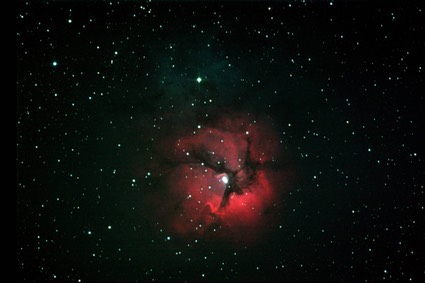
The Van Allen Observatory is a 17 in f/6.8 Corrected Dall-Kirkham reflecting telescope, owned and operated by the University of Iowa Department of Physics and Astronomy. It is stationed on the roof of Van Allen Hall in Iowa City, and is used for undergraduate labs, public outreach, and instrumentation development.

1. Watch the Van Allen Observatory Introduction Video.
2. Using the Rise and Set Calculator on the Rigel website (RST Calculator), determine if the objects your group has chosen are observable by VAO tonight. Fill in the chart for each object, and if it isn’t above the horizon tonight, be sure to note that in the appropriate column.
Once you have picked an astronomical object to observe, you need to determine if your science target is above the horizon at night. On the Rigel website, you can use the rise and set calculator (RST) to do this. Read through the tutorial on how to read the RST tool. The best time to observe a target is when it is transiting the meridian, which is when the target is at the highest elevation for the night.
3. Why does VAO have different filters? Explain specifically the purpose of the filters.
While it is useful to have RST calculator to be accurate for your observations, it is also important to know how to determine if a star is above the horizon without the RST calculator. Remember that we can do this by knowning the right ascension of the Sun in the month of our observations.
4. Choose one object that is observable during Clear Skies student observing hours and determine the filters and exposure times needed to image your object.
Now that you understand how to determine if your target object is observable, you need to decide how you will observe it. The Planning Tools page on the Rigel website has general information about filters and exposure times. Read through the page and examine the examples it gives for both filters and exposure times. It’s important to choose the appropriate filters and exposure times for your object since some filters trace atomic transitions or specific elements. For example, if you wanted to learn about star formation forming in a galaxy, you might use the H alpha filter, and you would need between 60 and 90 seconds of exposure time.
As a General guide, extended objects such as galaxies and nebulae should be imaged with a 60 second exposures for broad band (N,L,R,G,B,W) filters and 120 seconds for narrow band (H,O,S) filters. (An importaint exception to this rule is M42 and M 43, which will need 5 second exposures.) Star clusters should be imaged with 5 to 10 second exposures. Each solar system object is different, so ask your TA for advice reguarding what you want to image. In general, stars that you can see with your naked eye are too bright to be imaged using VAO.
5. What does it mean if VAO has a resolution of 0.9 arcseconds? If the VAO camera has 1024 pixels on each side, what is the field of view of VAO? Explain what these parameters mean and why they are important when setting up observations.